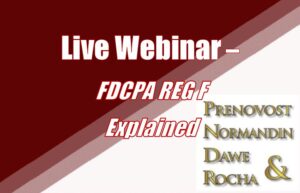The Keys to Effective Bankruptcy and Repossession Strategies
As consumers struggle to make payments, it is vital for financial institutions to implement successful bankruptcy and repossession strategies. This is especially critical today, with inflation, mass layoffs, costof-living increases, high interest rates and the resumption of student loan payments contributing to consumers’ plummeting financial health. MarketWatch Guides reported that, between 2022 and 2023, U.S. household debt surged by a staggering $800 million, reflecting a 4.8% uptick, while credit card debt skyrocketed by 16.6%.
Higher amounts of debt bring higher delinquency rates – and bankruptcies and repossessions soon follow. Bankruptcy filings saw a noticeable increase in 2023, with consumer Chapter 13 and Chapter 7 filings spiking by 18% and 17%, respectively.
The Federal Reserve Bank of New York reported that repossession rates are the highest seen since the fourth quarter of 2010, with a current 7.7% annual rate of consumers behind on auto payments.
As your financial institution handles the high rates of delinquencies, bankruptcy filings and repossessions, it is critical to implement various workflow strategies that will help regain lost assets, effectively assist accountholders and maintain compliance standards.
Equip your financial institution for success and embrace these key ideas in your bankruptcy and repossession strategies:
▪ Establish Guidelines and Processes – Implementing distinct processes for working accounts, such as a roadmap or checklist, is imperative. These guidelines must be sufficiently detailed to enable seamless continuity, even in the absence of a key team member.
Ensure familiarity with all processes to avoid situations where employees are uncertain about the next steps. Whether managing accounts internally or outsourcing, these processes will serve as firm guidelines when determining responsibilities within the workflow, enhancing efficiency and mitigating compliance risks.
▪ Prioritize Communication – Keeping an open line of communication is vital to success. Have clearly defined roles, responsibilities and expected timelines and deadlines, whether working on these accounts in-house or outsourcing.
Support an open and inclusive environment to avoid exclusion and missed questions. Facilitate seamless operations by scheduling regular weekly check-ins with the appropriate teams to address questions, troubleshoot any issues and ensure all processes are running smoothly. Address any issues or process improvements that are flawed.
▪ Take Ownership – Invest time and effort into gaining comprehensive knowledge of the processes involved with bankruptcy and repossessions. Proactively introduce new policies or procedures to enhance efficiency. Leverage external resources to help round out your knowledge.
Financial institutions that excel often have employees who take full ownership of their bankruptcy or repossession responsibilities, limiting the need for unnecessary questions and fostering clear communication and effective workflow strategies.
▪ Knowledge is the Greatest Power – The more you understand the industry’s current trends and best practices, the better equipped you will be to manage influxes of repossessions and bankruptcies. Embrace diverse perspectives by learning from different stakeholders, such as repossession agents, lenders and even borrowers themselves, to gain a comprehensive understanding of the dynamics at play. Actively seek opportunities for continuous learning, whether through seminars, subscribing to industry publications or conducting your own research.
Utilize these resources to stay on top of the latest bankruptcy and repossession information and trends:
Bankruptcy:
- Digital Bankruptcy Success Training by Steve Kreitlow, Continuing Education Facilitator at TriVerity and The Loan Service Center
- Creditor Attorney, Eric North, NorthLegal Training and Publications
- American Credit Acceptance (ACA)
- American Bankruptcy Institute
- Local or online bankruptcy courses
- Attorneys – If your financial institution uses an attorney, that individual could potentially be a great resource to present or teach on this topic.
Repossession:
- Auto Remarketing Magazine
- Auto Finance News
- American Recovery Association (ARA)
- National Recovery Agency (NRA)
- Local financial institution chapter meetings
Success in bankruptcy and repossession strategies hinges on a combination of comprehensive workflow strategies, clear communication practices, embracing ownership and a dedication to learning and innovation. Embracing these strategies enables employees to protect their financial institution’s assets, providing healthy risk management within their respective departments and equipping them to navigate the complexities of the job.
Is your financial institution equipped to handle the complexity or volume of bankruptcies and repossessions? Consider contacting an outside vendor like The Loan Service Center and ask questions to determine your needs and next steps.
By: Shannon Betz, Extended Services Supervisor, The Loan Service Center
Shannon Betz is the Supervisor of Extended Services for The Loan Service Center. She has a degree in paralegal studies with an emphasis on bankruptcy. She brings over 18 years of experience in the collection world and extensive knowledge of bankruptcy. Shannon’s primary responsibility is overseeing the bankruptcy and repossessions that The Loan Service Center coordinates and handles for our clients.
Want to hear more from Shannon? Attend her session, Future-Proofing for Repossessions, Remarketing and Bankruptcies, at the 2024 TriVerity Collection Academy on October 1-2, 2024.
The Keys to Effective Bankruptcy and Repossession Strategies – The Keys to Effective Bankruptcy and Repossession Strategies – The Keys to Effective Bankruptcy and Repossession Strategies

TriVerity is a full-service collection agency managing non-performing and charged-off loans with a comprehensive menu of third-party collection services. Since 1990, TriVerity has worked with over 2,700 financial institutions nationwide and is a leading industry expert for financial institution collections of all loan types. The Loan Service Center (TLSC) provides first-party delinquency management to minimize loan loss by managing early-stage delinquency. TriVerity and TLSC’s broad spectrum of collection resources and extensive training programs help financial institutions manage and mitigate loan delinquency rates. Our agents work under the direction and procedures of financial institution collection departments.
TriVerity & The Loan Service Center | 800.377.1798 | triverity.com













Facebook Comments